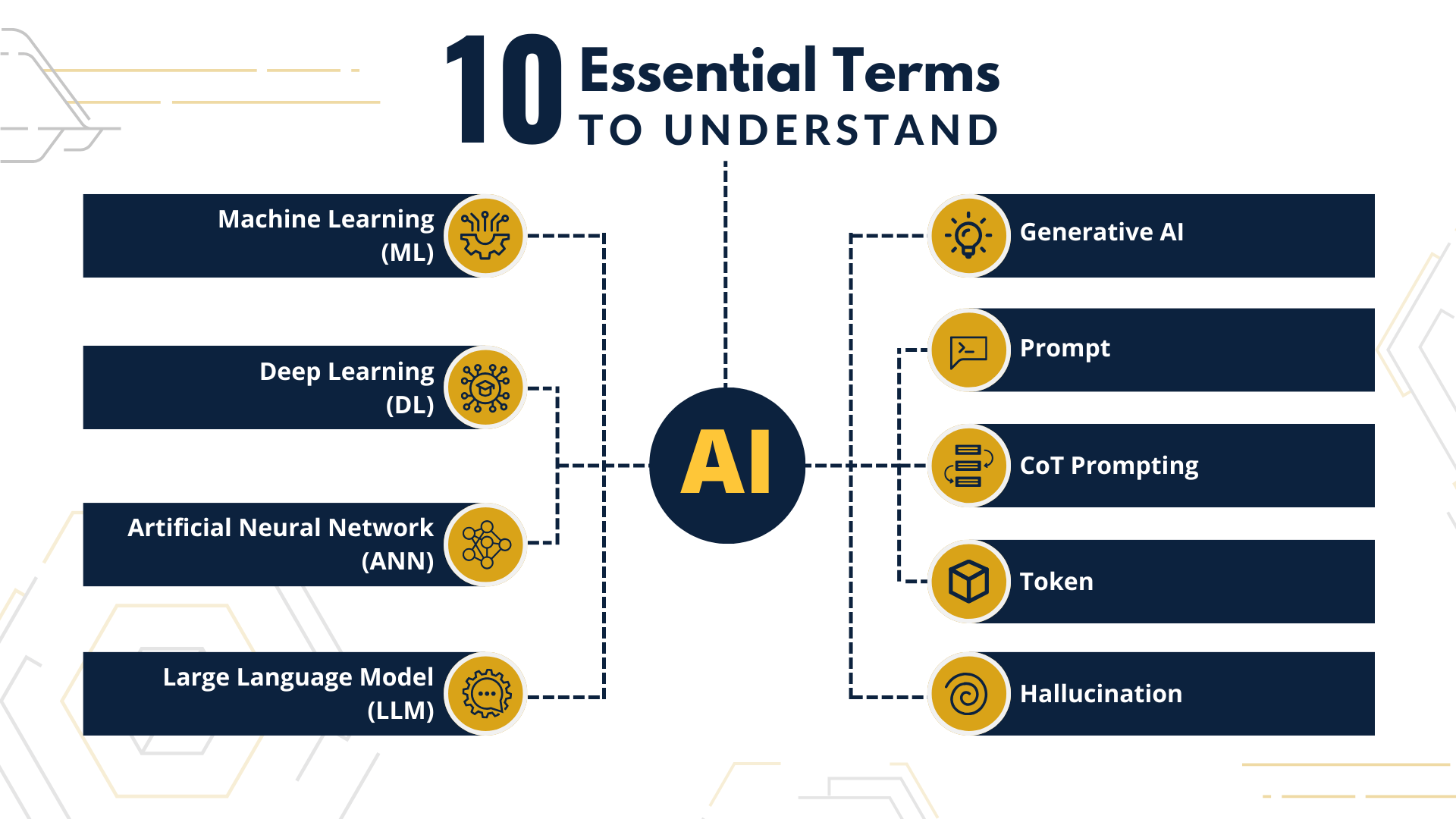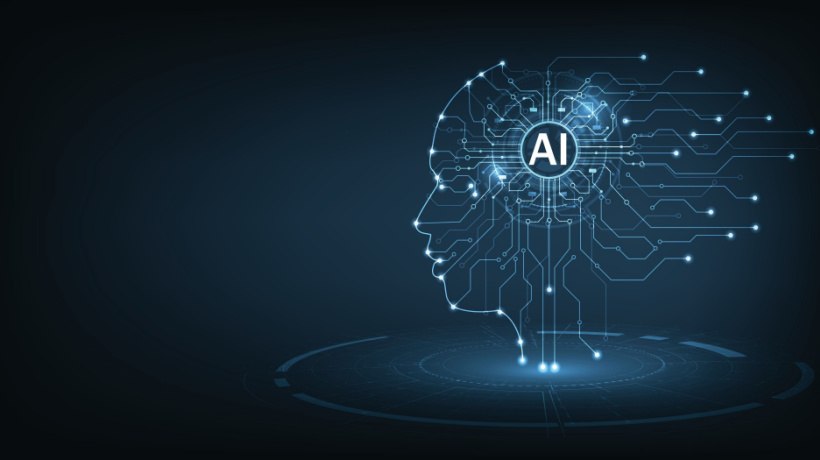Demystifying AI By Unveiling Essential Terms
Artificial Intelligence (AI) has become a buzzword in recent times and is definitely here to stay. And, of course, that is due to the numerous applications we discover daily for it, not only for L&D but in multiple fields. Therefore, it is essential to understand Artificial Intelligence. However, the jargon associated with AI can sometimes be overwhelming. Here, we outline ten essential AI terms!
- Artificial Intelligence (AI)
- Machine Learning (ML)
- Deep Learning (DL)
- Artificial Neural Network (ANN)
- Large Language Models (LLM)
- Generative AI
- Prompt
- Chain-of-Thought (CoT) Prompting
- Token
- Hallucination

10 Essential AI Terms To Understand
Artificial Intelligence
Artificial Intelligence refers to the development of computer systems that can perform tasks that typically require human intelligence. It encompasses a vast range of technologies and techniques to simulate intelligent behavior. Think of AI as the virtual assistant on your smartphone that can understand your voice commands, provide recommendations, and learn from your preferences over time.
Machine Learning
Machine Learning involves algorithms and statistical models that enable computers to improve their performance on a specific task without explicit programming. It focuses on pattern recognition and learning from data. Your email spam filter is a machine-learning system that learns to identify and filter out spam messages based on your actions and feedback. Machine Learning is a subset of Artificial Intelligence. Deep learning, neural networks, and large language models are advanced techniques within Machine Learning.
Deep Learning
Deep learning is a subset of Machine Learning that involves neural networks with multiple layers (deep neural networks). These networks can automatically learn to extract features from data and make complex decisions based on large amounts of data. Facial recognition in photos is a result of deep learning, where the system learns to identify features like eyes, nose, and mouth to recognize a person.
Artificial Neural Network
Artificial neural networks are computational models inspired by the human brain structure. They consist of interconnected nodes (as neurons) organized in layers, each layer processing and transforming data. For example, handwriting recognition software uses neural networks to understand and convert handwritten text into digital characters. Neural networks are fundamental to both Machine Learning and deep learning. Deep learning relies on neural networks with multiple layers.
Large Language Model
Large language models are advanced AI models trained on vast amounts of text data, enabling them to understand and generate human-like language. Virtual assistants like Siri or Alexa utilize large language models to understand and respond to natural language queries. Large language models are a product of deep learning and are part of the broader field of Artificial Intelligence.
Generative AI
Generative AI refers to Artificial Intelligence systems that are capable of creating new content such as text, images, or music. These systems learn from existing data patterns and generate fresh, original content. Generative AI is behind tools that can create realistic-looking images, or writing assistant tools that help to create content based on a topic, such as ChatGPT or Copilot. Generative AI is a type of application within the broader field of AI and often involves the use of large language models.
Prompt
A prompt is an input or instruction given to an AI system to perform a specific task. It can be a query, sentence, or command that initiates the AI's response. Asking a language model, "translate this English text to French," is a prompt for the model to generate a French translation. Another example is an instruction to create a scenario-based question in a specific subject area. Prompts are essential in instructing AI systems, and they play a role in tasks involving large language models and generative AI.
Chain-of-Thought Prompting
Chain-of-thought prompting is a technique used in AI systems that involves providing the system with a series of prompts that guide it through a logical sequence of thoughts. This technique helps the AI model maintain context and coherence in generating responses. It also encourages the large language model to explain the reasoning behind the responses it generates.
For instance, you might start with a prompt like "describe the weather," followed by "how does it affect outdoor activities?" The model uses the context from the first prompt to generate a more coherent and contextually relevant response to the second prompt. This technique is useful when we need to guide an AI model through a logical sequence of prompts.
Token
In Natural Language Processing, a token is a unit of text that is processed by the AI, typically representing a word or a part of a word. For example, in the sentence "AI is amazing." the tokens could be "AI", "is", and "amazing.". However, a token doesn't have a fixed length in terms of characters or words. Instead, a token can vary based on the complexity of the language and the content.
For practicality, you can calculate tokens considering the approximation that usually, one token is approximately equal to three-fourths of a word. Tokens are fundamental in processing and analyzing text data, a crucial aspect in tasks related to large language models and Natural Language Processing within the broader AI field.
Hallucination
Hallucinations refer to instances in which an AI model generates outputs that are not based on real data, but rather on patterns or biases learned during training. This can result in incorrect or false outputs. For instance, when generating text, the model may introduce fictional details based on the training data, potentially leading to the spread of misinformation containing inaccurate or biased information.
Hallucinations can occur in various AI models, including those based on generative AI and large language models. It is important to remember that AI systems can't distinguish between what's real and fake. Therefore, it is our responsibility to fact-check and provide proper grounding when possible.
Conclusion
Understanding AI terminology is a good starting point for Instructional Designers, developers, enthusiasts, and anyone interested in considering AI for L&D. Moreover, familiarity with these terms will give you more confidence when exploring the field. It is important to note that these essential AI terms are not merely jargon, but rather they represent the fundamental concepts for innovation, problem-solving, and endless possibilities!
If you need further assistance in exploring AI tools or integrating these concepts into your learning initiatives, please feel free to contact us.
Image Credits:
- The infographic within the body of the article was created/supplied by the author.









